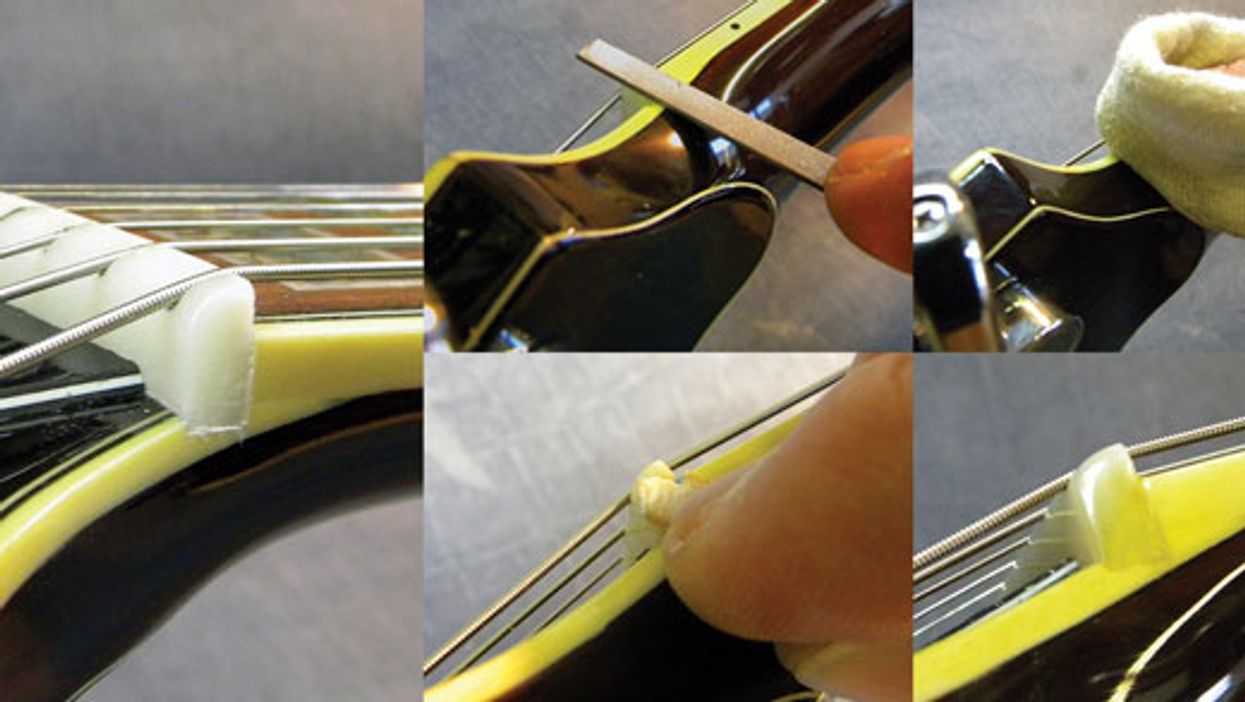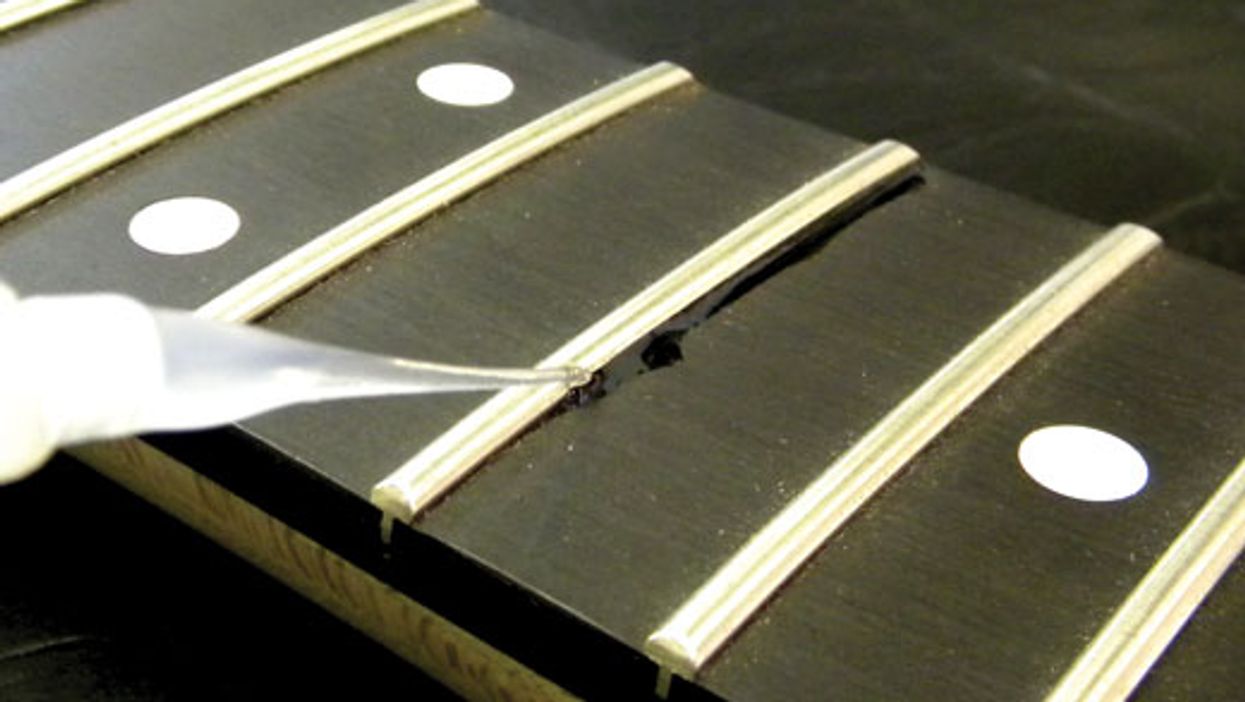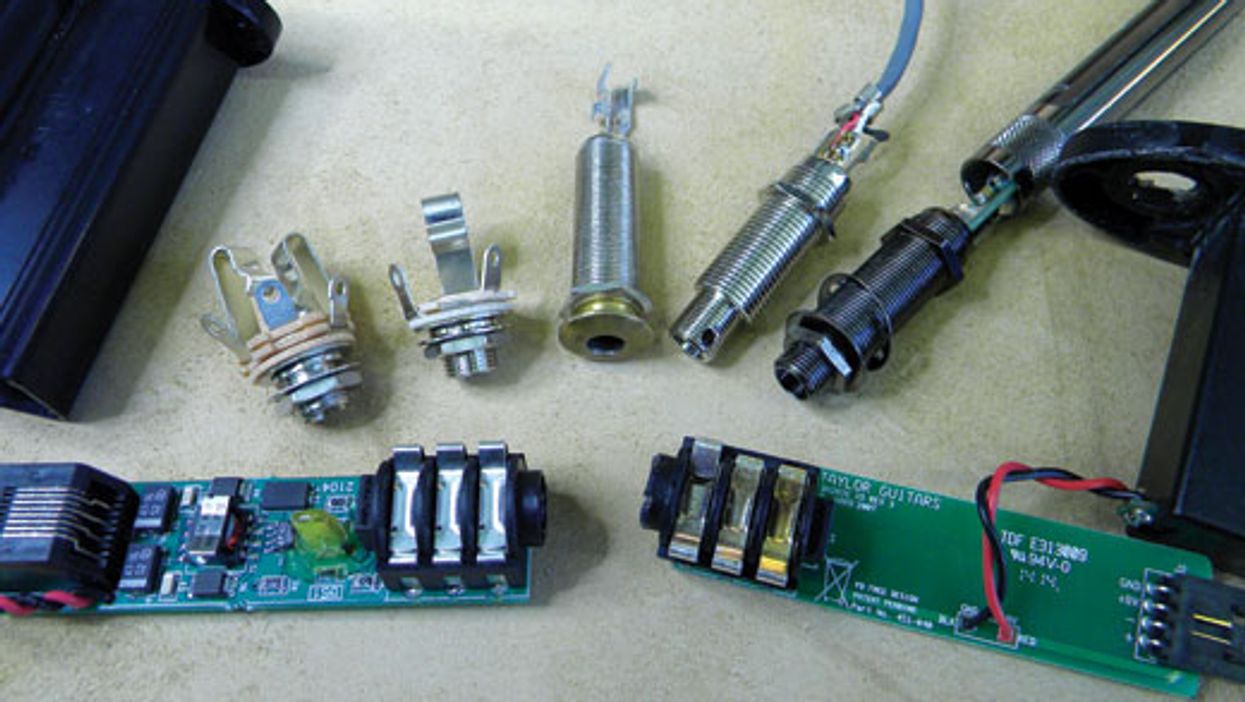String trees are tiny and often go unnoticed, but they play a vital role on flat, Fender-style headstocks. Also called string retainers or guides, they secure the first two (or sometimes four) strings between the nut and tuners. Photo 1 shows a guitar configured with two “butterfly" string trees holding down the top four strings.
On both guitar and bass, a string tree's primary function is to provide the correct amount of downward pressure on a string so it doesn't rattle and buzz within its nut slot. This downward pressure also ensures that a string will sustain properly when played open. If an open string isn't securely seated in its slot—essentially pinned down the way you'd press a string against a fret—it won't sound as loud or clear as it should.
Whether or not a guitar or bass requires string retainers is determined by how its headstock is constructed. For example, Gibson headstocks tilt back at an angle from the fretboard, and this angle is sufficient to create the necessary downward pressure to keep strings firmly seated in their slots en route to the tuner posts. By contrast, Strats, Teles, and most other guitars with six-in-a-row tuners have flat headstocks that run parallel to the fretboard. On these headstocks, the strings that have to travel the longest distance from the nut to the tuner posts need hardware to create this essential downward pressure.
A string tree's primary function is to provide the correct amount of downward pressure on a string so it doesn't rattle and buzz within its nut slot.
A string tree's primary function is to provide the correct amount of downward pressure on a string so it doesn't rattle and buzz within its nut slot.
Most of us never think twice about string trees until there's a problem. I've already described one—the rattle or sitar-like buzz that results from insufficient downward pressure behind the nut. But if a string tree creates excessive pressure, this can cause premature wear in the affected nut slots and also create tuning issues. And here's another consideration: If you have a whammy bar, certain types of string trees can interfere with the string returning to pitch after you release the bar.
To summarize, string trees can help or hinder your guitar's performance. Let's take a closer look and discuss ways to deal with potential problems.
Design and construction. String trees come in a variety of materials and styles. Most are metal, like the butterfly, disk, and barrel types found on Fender guitars. The metal trees will work, but if you do a lot of bending or use a whammy bar, you'll probably experience tuning problems. Why? Every time the string changes tension against the tree, the metal-to-metal contact creates friction that can cause the string to hang slightly at this point of contact.
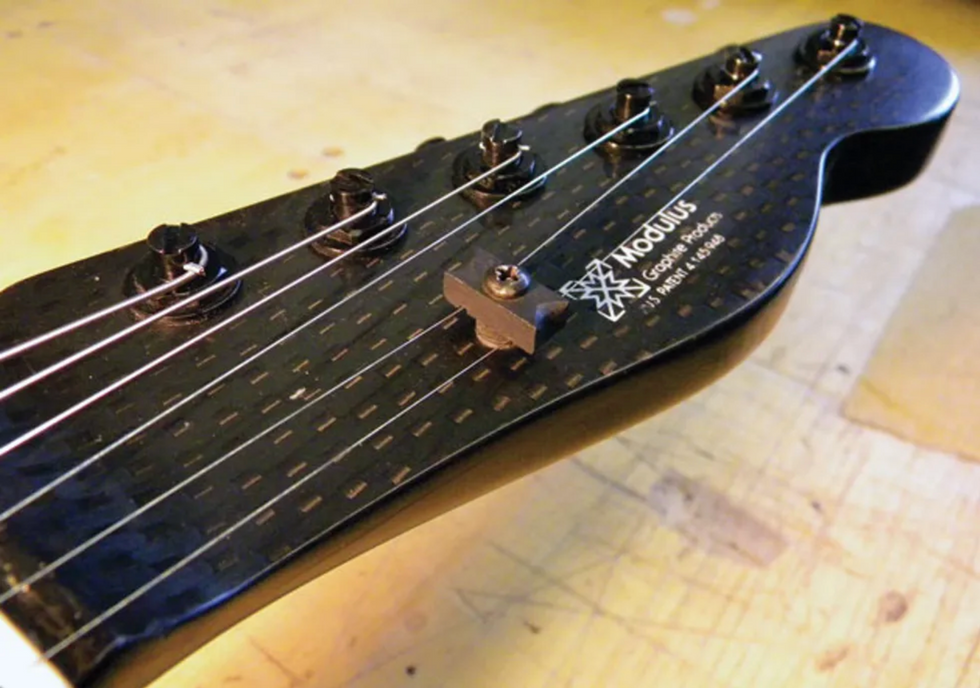
Photo 2
To reduce friction—and thus improve tuning stability—you have two options: use a string tree made from a slippery material such as graphite (Photo 2), or install a string tree with built-in rollers that turn with the string as you bend or use the whammy bar (Photo 3).
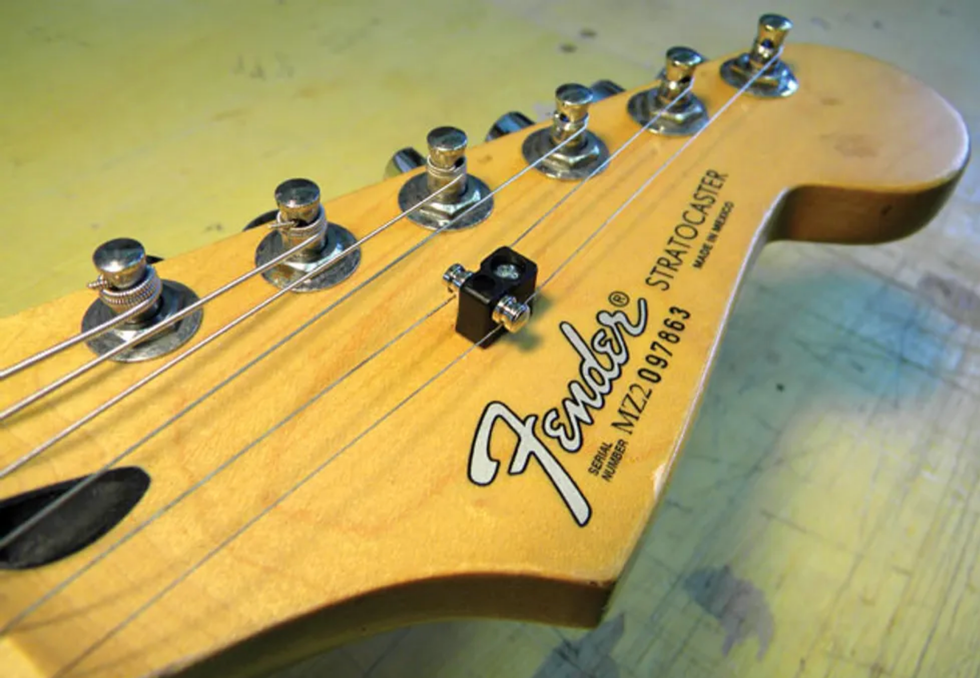
Photo 3
Both types of retainers accomplish the goal of reducing metal-to-metal friction. I've had great success with Graph Tech string trees, which are made from a synthetic material impregnated with a Teflon-like lubricant, and roller string trees from All Parts.
What's your angle, man? The amount of downward pressure a string tree creates is determined by its location and how high it sits off the headstock. Assuming an identical location, a lower retainer—one that's close to the headstock—will create a steeper angle between it and the nut than a retainer that sits higher off the headstock. Getting the correct angle is critical for avoiding wear (too steep an angle) or sonic artifacts (too shallow an angle).
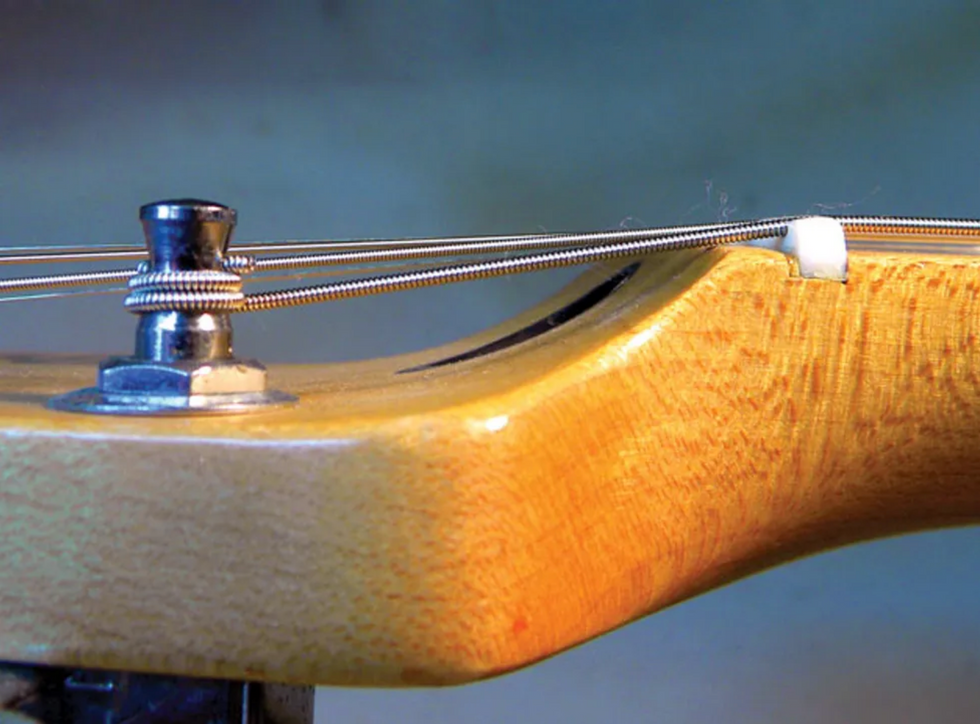
Photo 4
For a guitar equipped with a single string tree to hold the 1st and 2nd strings, the angle between the retainer and nut should be about the same as the angle between the nut and 6th-string tuner (Photo 4). For guitars that require a second string tree for the 3rd and 4th strings, the angle should approximate that of the 5th string.
Many string trees sit on a separate post or standoff spacer that determines the retainer's height. The attachment screw passes through this washer-like cylinder and goes into the headstock (Photo 5). When the post is a separate piece from the section that actually holds the strings, you can adjust the retainer's height—thereby controlling the string angle—by inserting a shorter or taller spacer.
If the string angle is too shallow and you have a removable metal or plastic spacer, you can increase the angle buy sanding or filing the spacer to reduce its height. Alternatively, you can substitute a shorter spacer: Electronic supply companies sell standoffs for PC boards, and some enterprising guitarists adapt the ball-ends of bass strings for this purpose. Stacking small washers can work too. Whether you need to go up or down, it shouldn't be too hard to adjust the height of your string tree by either modifying it or swapping it out.
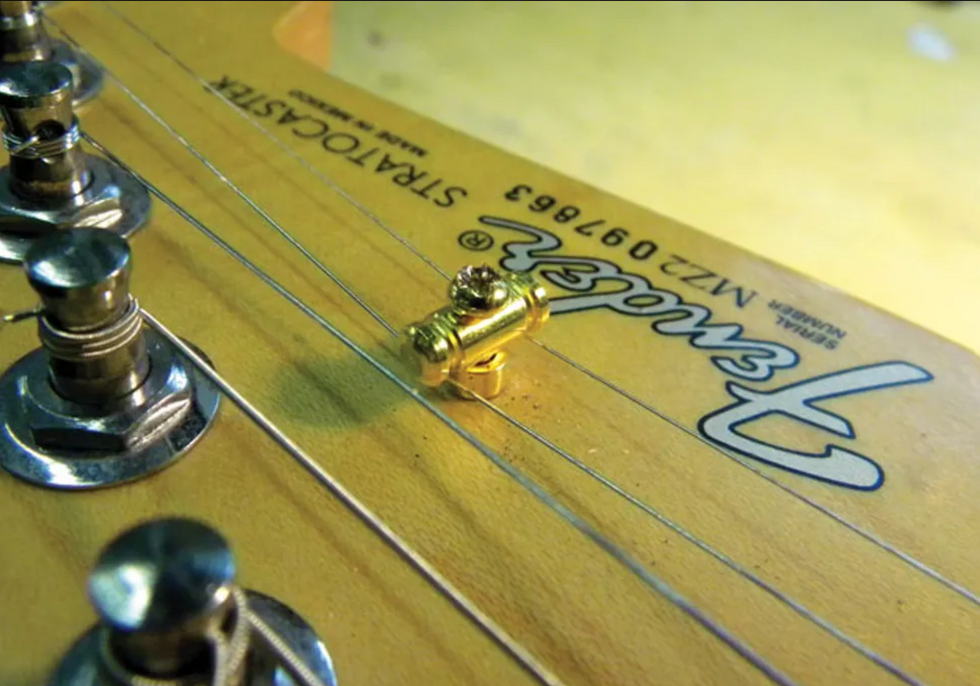
Photo 5
Replacing the string tree. If you opt to upgrade to a roller or graphite retainer, it's a very simple project. All you need is a small or medium tip Philips head screwdriver. Lift the strings out from the retainer, remove it, screw the new one in place, and you're done. You might encounter small variations in screw size and threading, but most manufacturers use a consistent size. You can use your original screw if it's in good condition and fits the new retainer.
First-time installation. If you're installing a string tree on a headstock that's never had one—on a replacement neck, for example—string up the guitar and lay the new tree on the corresponding strings, midway between the nut and closest tuner. Confirm the strings are lined up evenly and then, with the screw in place, press down on the tree so the screw makes a small indentation in the headstock. This indentation should lie exactly between the two strings. Use it as a guide for drilling the mounting screw hole.
Start with a pilot hole, using a very small bit. For the screw hole proper, be sure to choose the correct drill bit—it should be slightly smaller than the screw. Measure everything twice, go slowly, and be careful how deep you drill—you don't want to drill completely through the headstock! Before installing the screw, lubricate its threads with a bar of soap or candle wax.
Inserting a delicate screw into a hard maple headstock requires skill, so don't attempt to install a new string tree unless you have the right tools and experience. If you're unsure about your abilities, take the guitar to a qualified repair tech or luthier.
Goodbye string trees. Some manufacturers offer locking tuners with staggered posts. Intended to create the required string angle on a six-in-line headstock without using string trees, staggered posts start out at a normal height for the 6th string and then gradually reduce height, which puts the shortest post furthest from the nut. Depending on the geometry of your headstock, you may be able to eliminate string trees altogether by using these tuners, but the only way to know for sure is to install them and see if you experience any of the sitar sounds or sustain issues that come from having too shallow an angle on your top strings. In most cases, you probably won't need string trees if you have staggered tuners.


